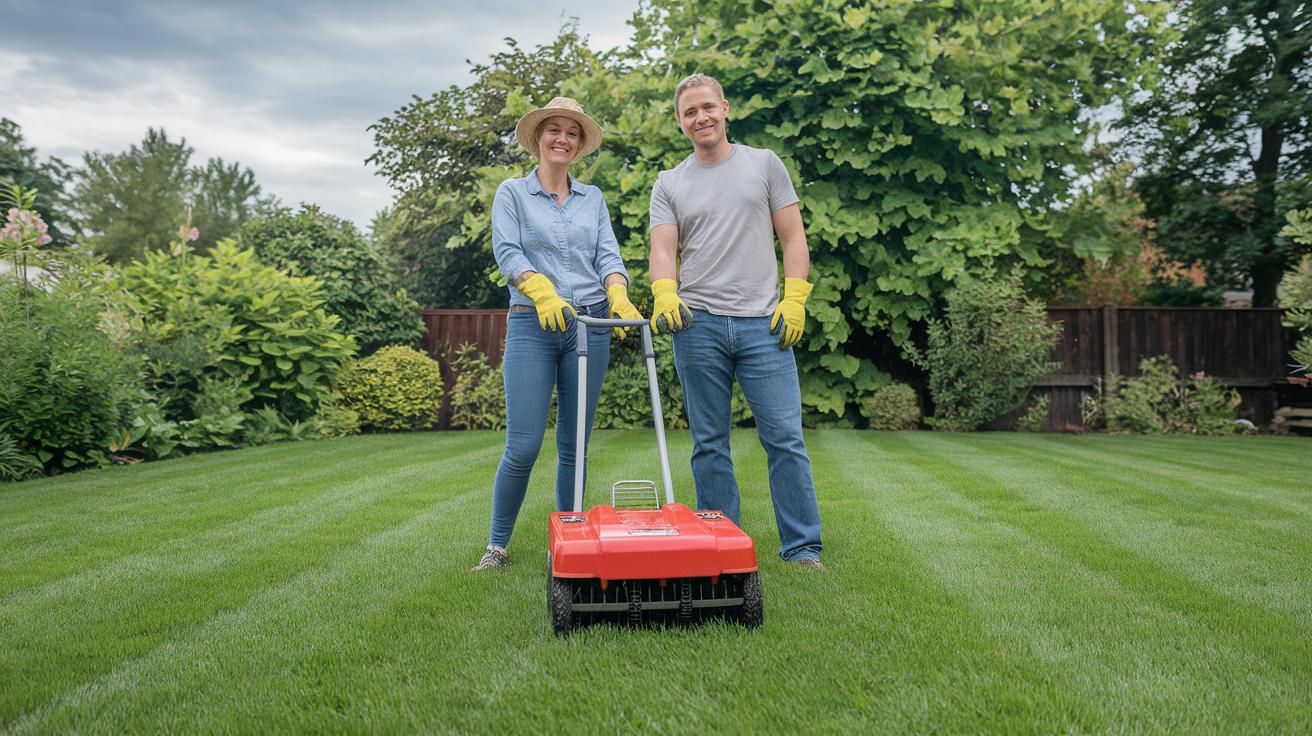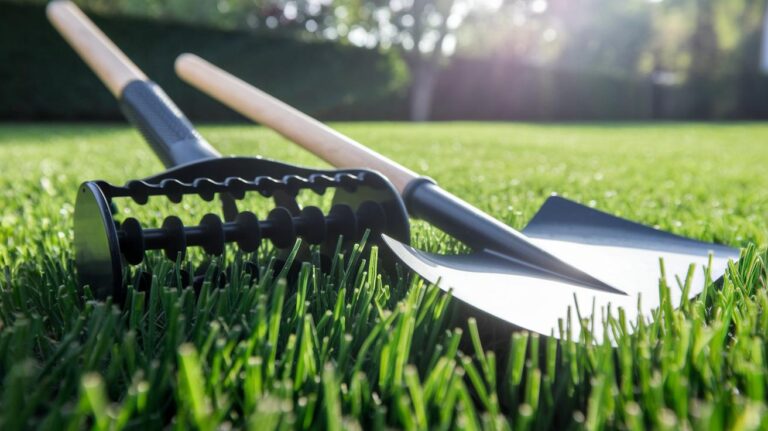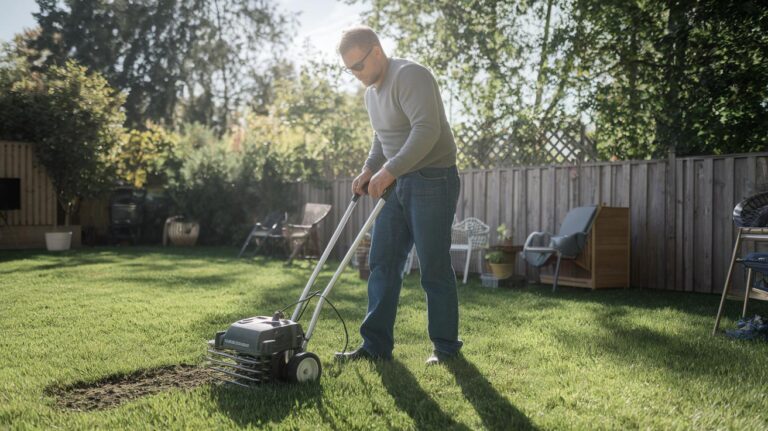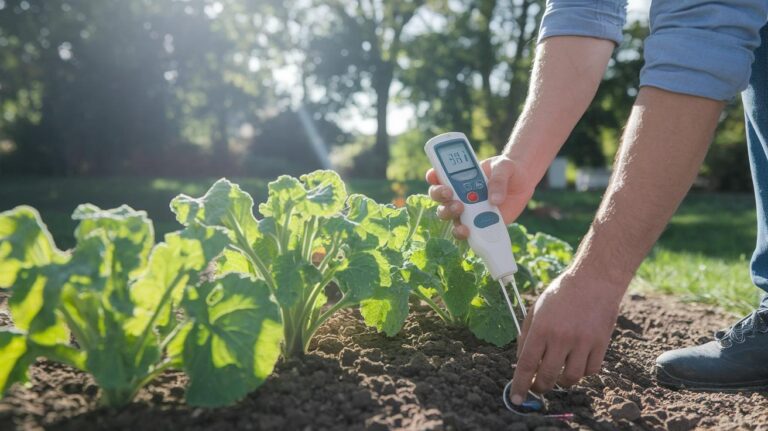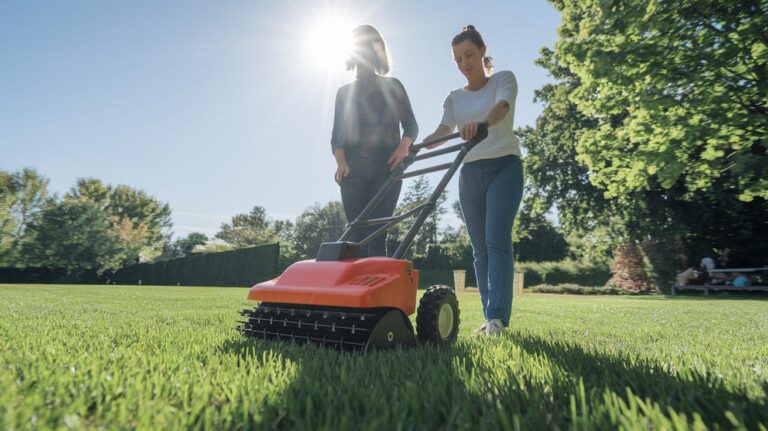What To Do After Lawn Aeration Powerful Tips
Ever think aeration (making small holes in your lawn) is the final step to a perfect yard? I used to. But those little soil plugs (tiny bits of dirt) falling back in are like sponges in the warm earth, soaking up water and nutrients.
Skip the follow-up and your lawn might stay thirsty or get squashed underfoot. And brown patches will show up faster than you think.
Here’s what I do after aerating. First, water just enough so the holes stay damp but not muddy.
Then drop seeds into each hole. Yes, pop one right in. Next, feed new shoots with a light sprinkle of compost (rot-down plant matter that boosts soil).
Planting now sets you up for a summer of soft, green blades tickling your toes. By the way, my cat loves rolling in the fresh grass. But back to your lawn, stick with these steps.
Ready to wow your neighbors? Keep at it and soon everyone will be asking for your secret!
Quick-Start Checklist After Lawn Aeration
- Let soil cores (small plugs of earth) sit on your lawn so they crumble into the warm earth, feed soil life, and chip away at thatch.
- Give it a gentle drink of water to help those cores settle in. Oops, don’t drown it. Aim for soil that feels like a moist sponge, so seeds in the holes get just the right damp start.
- Keep kids, pets, and anyone from stepping on the aerated spots. That way new roots can grow down without getting squished.
- Overseed patchy areas by dropping grass seed into each aeration hole (tiny openings made when you poke the soil). It locks the seed right against the damp ground.
- Sprinkle a light starter fertilizer (nutrients for new grass) to feed seedlings without burning them.
Read on for detailed schedules, fertilizer rates, seeding tips, ideal mowing heights, and simple weed control.
Watering Schedule and Techniques After Lawn Aeration
Right after you aerate (make small holes in your lawn), give your grass a light watering. It helps the soil settle around roots and brings moisture where it’s needed. I love that feeling when the warm water soaks in and the earth feels like a soft sponge.
Water light and daily until you see little green shoots, usually in 10 to 14 days. Early morning between 4 and 8 AM or late afternoon is best. Have you ever smelled that fresh-grass morning air? The grass needs time to dry before night so it skips fungus parties.
| Stage | Duration per Zone | Frequency | Best Time |
|---|---|---|---|
| Before Seedlings Appear (10–14 days) | Clay: 1 hr Sandy: 30 min |
Daily | 4–8 AM or late afternoon |
| After Germination (when seeds sprout) | 30 min | Daily | 4–8 AM |
For clay soil, run each sprinkler zone about one hour to deliver roughly half to a full inch of water. Sandy soil drains faster, so 20 to 30 minutes will moisten the top layer without washing seeds away. Walk the edges and feel the dirt, you know, until it’s like a damp sponge. That check tells you you’re on track.
Once that soft green carpet fills in, switch to a 30-minute soak each morning. This gives new grass a drink before the sun turns up the heat and helps blades dry off. It’s a simple timing tweak that keeps fungus spots away and saves you from evening drips.
Fertilizer Recommendations for Aerated Lawns
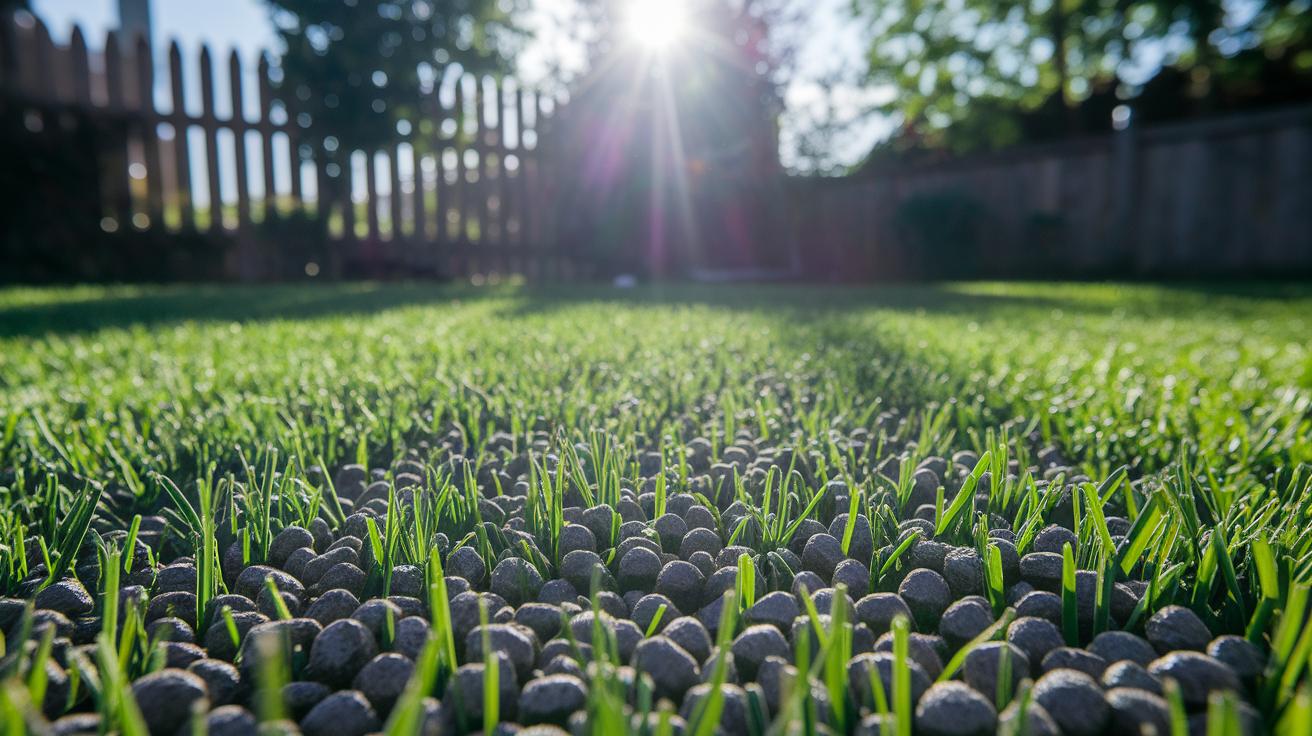
You just aerated (made tiny holes in) and seeded your lawn. Those little channels act like tunnels, guiding nutrients right to the roots. Now is the perfect moment to feed your turf.
- Choose a slow-release fertilizer with a 3-1-2 mix of nitrogen (for new green shoots), phosphorus (for strong roots), and potassium (for stress resistance).
- Spread only half the amount the bag recommends. Too much fertilizer can scorch fragile grass blades.
- Wait at least four weeks before using any weed killer. Young seedlings can’t handle herbicide stress.
- For a gentle boost, try organic fertilizer for lawn. It feeds soil microbes (tiny helpers in your dirt) and releases nutrients slowly without harsh chemicals.
- Check soil pH every two years with a simple home test. Add lime to cool-season grass if it’s too acidic, and save liming warm-season turf for the fall.
Give your lawn a light watering after you spread the granules. Picture your soil like a sponge: moisten it, let it soak, then fluff it up with a rake. Oops, I once skipped this and my grass stayed thirsty. Have you noticed how one good drink brings out that deep green?
If your blades still look pale after two weeks, mix a half-strength feed and apply. It’s a gentle pep talk for your turf and helps it bounce back.
Overseeding and Topdressing Best Practices After Aeration
Pick the right grass seed for your lawn. If you’ve got cool-season types like fescue, rye, or bluegrass, go for 5–10 pounds per 1,000 sq ft when your soil sits around 50–65°F. For warm-season favorites, bermuda or zoysia, scale back to 1–3 pounds per 1,000 sq ft once the ground warms past 70°F.
Rake lightly across the aerated holes. This clears away dead bits and fluffs the topsoil so seeds can nestle into those openings. Then scatter your seed evenly, no bare spots, please! Oops, dropped a handful? Just spread it out gently with the back of your rake.
Once your seeds are down, press them into the aeration holes. You can stroll over the area in soft shoes or give it a quick roll with a lawn roller. That close seed-to-soil hug stops them from drying out and drifting away.
Now for the fun part: topdressing. Scoop a thin, ¼-inch layer of screened compost (decayed organic matter that enriches soil) or fine topsoil and spread it evenly. Think of it like a cozy blanket. It locks in moisture, shields your seeds, and feeds all those helpful microbes.
Step on the compost to check it, does it feel like damp coffee grounds under your foot? Perfect. But if it feels too thick, the tiny grass shoots might struggle to poke through. Keep it light, no more than that quarter-inch layer.
Next, give everything a gentle drink with a fine spray. You want the soil and compost just damp, not puddles that could wash seeds away. Check it every day. The topdressing should stay snug against the soil, and in about two weeks, you’ll spot those first green tips.
When you see seedlings popping up, switch back to your regular watering routine. Your new grass will soon be off and running, ready to fill in and make your lawn look lush again.
Mowing Guidelines for Newly Aerated Lawns
Have you just aerated your lawn? Aerated means making tiny holes in the soil so water and air can reach the roots. Now wait until grass blades reach about three to four inches tall. That usually takes ten to fourteen days after you’ve scattered grass seed (tiny seeds that grow into grass).
That pause gives your new grass time to send roots deep without getting nicked by your mower. It feels good to know you’re giving those tender shoots a fair head start. And you’ll avoid stressing the lawn too soon. Wow.
- Set your mower blade to the highest or second-highest setting. Cutting more than one third of the blade length stresses young grass.
- Mow once a week during active growth. This keeps your lawn even and avoids sudden shocks to the new grass.
- Leave clippings (cut grass bits) on the surface. They act like a mini mulch (thin layer that holds moisture) and recycle nutrients right back into the soil.
- Walk the lawn afterward and look for missed spots. You’ll see tufts leaning over. Just nudge them upright with a rake (tool with prongs for gathering leaves) before you call it a day.
Don’t worry if your first cut looks a bit uneven. Tiny quirks are part of the charm. Just stick to your weekly pace and watch your lawn fill in nicely.
Managing Foot Traffic and Weeds After Aeration
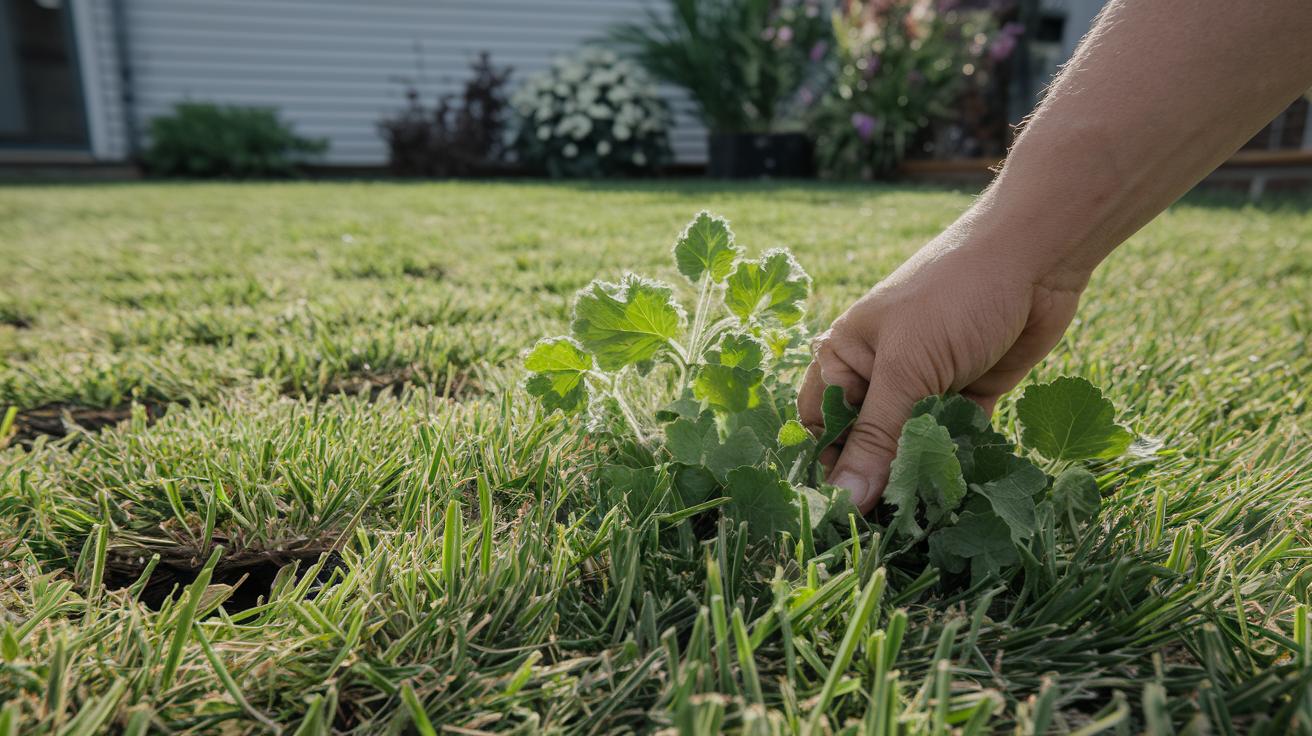
Hey neighbor, after aeration (poking small holes in your lawn so air, water, and nutrients can reach the roots) and seeding, step away from the lawn for at least a week. And if you dropped fresh seed, give it a month. This break stops the soil from getting compacted and lets those little green blades land softly. Have you ever felt the squishy soil under your boots? That’s perfect for new grass roots.
- Inspect weekly for tiny weeds poking up through the holes in the soil. Pull them early so their seed heads don’t spread.
- Hand-pull dandelions and clover (broadleaf weeds with wide, flat leaves) instead of spraying herbicide on tender grass tips.
- Delay pre-emergent herbicide (weed killer that stops seeds from sprouting) for about four weeks. That gives your young turf time to get strong.
- To prevent crabgrass, apply treatment when grass shoots are about three inches tall. Then you’ll stop it before it takes over.
- Scout for pest damage, look for little tunnels, chew marks, or fuzzy patches. Catch any bug trouble early on.
By the way, weeds love hiding where the lawn meets flower beds. Corners and edges are prime hideouts. I once set out garden flags to keep my cat and kids from wandering in. It’s a simple trick.
Gentle steps today pay off tomorrow. Your lawn will thicken up without weeds crowding out the new growth. You did that!
Long-Term Maintenance and Future Aeration Planning
Go ahead and jot this down in your garden journal. Cool-season lawns need aeration in early fall. Aeration means poking holes in the soil so air, water, and roots move more easily.
If kids and pets turn your yard into a play zone, you might aerate twice a year. That extra pass helps stop the earth from getting too packed. Warm-season grasses like bermuda or zoysia do best with core aeration in late spring before the summer heat sets in. Core aeration is when we pull out little plugs of soil to help roots breathe.
Grab a garden notebook or use your phone’s note app. Track each time you aerate, note the tine type, any soil test results, and tweaks like adding lime (rock powder that balances soil acidity) or compost (decayed organic scraps that feed your plants). Flipping through last season’s notes makes planning next aeration a breeze. No more guessing.
Thinking of renting a machine or calling in a pro? DIY handheld aerators can work fine. But pros have heavier gear that pulls perfect plugs without making your back ache. On a medium lawn, professional core aeration runs about $78 to $238. You can compare gear options at best aeration for lawn.
Here’s a little year-round chart I like.
| Season | Task |
|---|---|
| Spring | Soil test |
| Summer | Feed lawn |
| Fall | Aeration |
By sticking to that schedule, spring soil test, summer feeding, fall aeration, your grass will grow deeper roots. You’ll love that soft, springy feel every time you kick off your shoes. By the way, my dog Max naps right on the newly aerated patch.
Final Words
From the quick-start checklist we saw how to leave soil cores, water lightly, keep off feet and paws, overseed thin spots, and add a light starter feed.
Next up, you got the lowdown on watering schedules for clay or sandy soils, choosing the right fertilizer mix, topdressing seed holes, and mowing without stressing new grass.
We wrapped with tips on traffic limits and weed checks, plus a plan for your next aeration.
Now you know what to do after lawn aeration, read on for detailed schedules, fertilizer rates, seeding techniques, mowing heights, and weed controls.
FAQ
What steps should I take before and after lawn aeration?
Before and after lawn aeration involve prepping and follow-up to boost turf health. Mow slightly lower and water the soil first. After aeration, leave cores to decompose, overseed, apply starter fertilizer, then restrict foot traffic.
When and how should I water my lawn after aeration and seeding?
After aeration and seeding, water lightly to keep cores damp without puddles. Run sprinklers daily (0.5–1″ per zone) until seedlings emerge (10–14 days), then switch to 30-minute morning cycles.
When should I mow after aeration and seeding?
Mow when grass reaches 3–4″ tall, about 10–14 days after aeration and seeding. Cut no more than one-third of blade height and leave clippings to nourish the soil.
What fertilizer should I use after aeration?
Use a slow-release starter fertilizer balanced in nitrogen, phosphorus, and potassium to support root growth and stress resistance. Hold off on weed killers until new grass is established.
What to do after lawn aeration in the fall and in Texas?
After fall aeration, overseed cool-season grasses and apply starter fertilizer. In Texas or other warm-season regions, skip overseeding, focus on a light fertilizer, keep cores, and water to support existing turf.
How long does it take for aerated grass to recover?
Aerated grass typically recovers in 10–14 days as soil cores break down and seedlings fill gaps. Full turf strength returns in about a month as roots deepen and blades thicken.
Can I walk on my lawn after aeration?
You can walk gently on an aerated lawn, but it’s best to limit foot and pet traffic for at least a week (or one month if overseeded) to avoid soil compaction and protect seedlings.
What to do with holes after aeration?
Leave the holes and soil plugs in place so they decompose and feed soil microbes. Over time they fill naturally, improving drainage and nutrient uptake without extra work.

